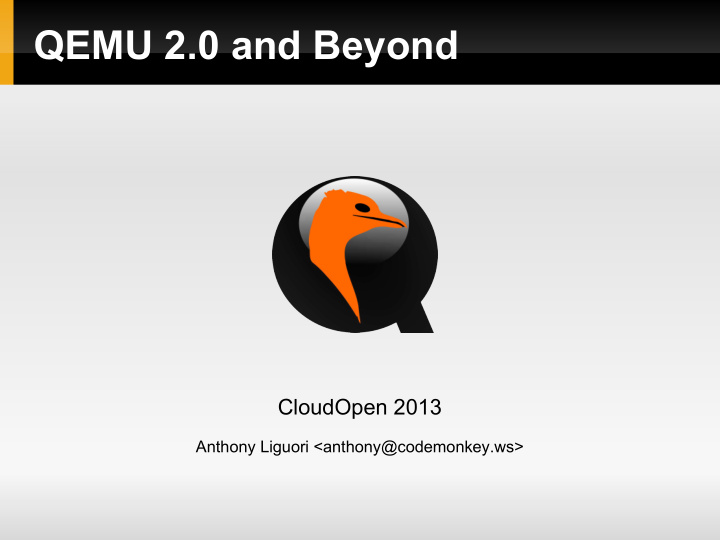



QEMU 2.0 and Beyond CloudOpen 2013 Anthony Liguori <anthony@codemonkey.ws>
About QEMU is a fast full system simulator and virtualization engine QEMU is Open Source hardware emulation KVM Xen Android SDK (fork) VirtualBox (fork) Just about every embedded SDK out there
Quick History Started in 2003 by Fabrice Bellard Author of FFMPEG, JSLinux, and lots of other cool things Portable Just In Time (JIT) translation engine for cross architecture emulation Quickly grew system emulation Starting with PC hardware Has been a grass roots, quiet community
Evolution of QEMU Linux user emulation System emulation Replace dyngen → TCG Virtualization support Management API Block layer ...
Growth of the Community 10+ years of community building Roller coaster ride Inclusiveness Wildly different features and missions Rich community Extremely complex command line There be dragons
Growth of the Community
Forks and Merges Not always positive Minor forks like qemu-kvm and qemu-dm A few cases where major forks almost happened Tremendous effort merging forks back Forks proved importance of compromise
Development Process Hierarchical maintainership 40+ submaintainers 250+ contributors Two month development cycle, one month stabilization period Major releases every 2 years, minor releases every 3 months
Features QEMU is the front line for Cloud Xen HVM and all KVM guests Primary interface that the guests communicate with is hardware The Linux Kernel unites all distributions QEMU unites the Open Cloud
Features – Virtual I/O VirtIO High speed paravirtual I/O framework Designed like hardware Network, disk, serial, hwrng, balloon, … Undergoing standardization via OASIS Emulated I/O still improving Improving support for VMware devices and more
Features - Graphics VNC and Spice support for remoting Javascript clients available Native WebSockets support Virgl 3D graphics for guests based on VirtIO Still a research project Very promising
Features - Storage Convergence around qcow2 New modes and extension mechanism Improved support for snapshots virtio-blk dataplane 95% of bare metal performance on large storage array
Features - Migration Convergance algorithm Must race guest to complete migration New techniques to win against guest XBLRE – Compression RDMA – Raw performance Guest delay – Cheat
Features - Migration Live block copy Cloud loves local storage Migration traditionally requires shared storage Live block copy allows movement of local storage Live update Reduce scheduled downtime by efficiently performing localhost migration Potential to combine with kexec for full system update
Features - Managability QEMU Monitor Protocol (QMP) JSON based RPC Formally specified in a schema language Support for commands and notification Rigid compatibility guarantees
Features - Security Virtualized hwrng Provide better entropy to guests Layered security model Unprivileged Mandatory Access Control via SELinux Sandboxed using seccomp mode 2
Features - Core QEMU Big Lock Introduction of VSMP mirrors Linux kernel Systematic break up of big lock to enable better scalability Have used many tricks to avoid it this long Unlike Linux, skipping ahead to RCU
Features – Predictions Command line interface will be overhauled Git style CLI GTK GUI will be expanded for desktop usage Storage layer will add RAID and rely less on Linux kernel We will solve migration backwards compatibility
QEMU in the Cloud - Consumer Should we care about the virtualization layer in the Cloud? Open Virtualization prevents the Cloud from becoming a Walled Garden Guests created on QEMU are portable across virtualization implementations Not true of proprietary hypervisors
QEMU in the Cloud - Vendors Cloud is about much more than virtualization Why invest is reinventing the wheel? Open Source is auditable Recent news events make this even more critical Ability to contribute to direction of technology
Questions Questions
Get Involved http://wiki.qemu.org/Contribute/SubmitAPatch qemu-devel@nongnu.org
Recommend
More recommend